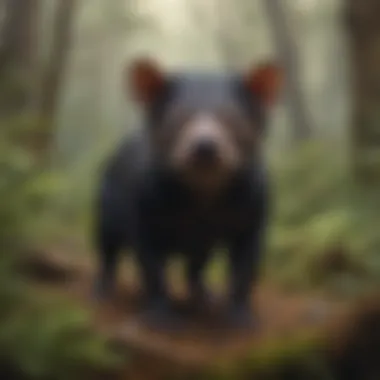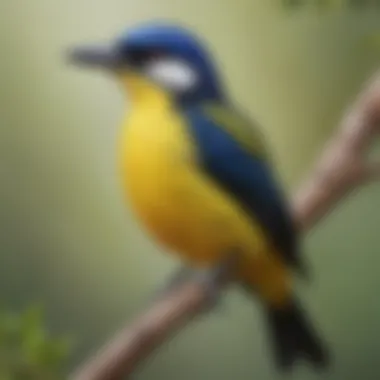Preserving Australia's Unique Endangered Species: A Conservation Journey


- Tips and Tricks
Overview of Australia's Biodiversity
Australia's biodiversity is a topic of paramount importance, particularly in the context of endangered species. The country boasts a rich tapestry of ecosystems, each playing a vital role in the preservation of its unique flora and fauna. Understanding the diversity of habitats and the species they support is crucial in mitigating the threats faced by endangered wildlife.
Rich Ecosystem Diversity
Variety of Habitats
The variety of habitats in Australia is unparalleled, ranging from lush rainforests to arid deserts. These diverse landscapes provide a home to a multitude of species, each finely adapted to their specific habitat. This variety not only fosters a rich array of flora and fauna but also contributes to the overall resilience of the ecosystem. The adaptability of species to their respective habitats highlights the intricate balance that is essential for maintaining biodiversity.
Unique Fauna and Flora
Australia's unique fauna and flora showcase a remarkable evolutionary history, with many species found exclusively on the continent. The distinctiveness of these species underscores the need for their protection, as their loss would represent a significant loss in global biodiversity. Understanding the unique features of Australia's fauna and flora is vital in devising effective conservation strategies that address the specific needs of these species.
Threats to Biodiversity
Habitat Loss
Habitat loss poses a significant threat to Australia's biodiversity, resulting from human activities such as deforestation and urban development. The destruction of natural habitats disrupts ecosystems, leading to the decline of species dependent on these areas for survival. Addressing habitat loss requires a multifaceted approach that balances development with conservation efforts to ensure the long-term viability of indigenous species.
Climate Change Impact
The impact of climate change on Australia's biodiversity is becoming increasingly pervasive, with rising temperatures and extreme weather events altering ecosystems. These changes pose challenges for species already facing pressure from other threats, further endangering their survival. Recognizing the interconnectedness of biodiversity and climate change is crucial in implementing adaptation strategies that safeguard vulnerable species.
Iconic Endangered Australian Species
Australia is home to a diverse range of iconic endangered species that face imminent threats of extinction, making their conservation crucial in preserving the country's unique biodiversity. These species not only serve as emblematic representatives of Australia's rich fauna but also play vital roles in maintaining ecosystem balance and health. The inclusion of these iconic species in this article sheds light on the urgent need for conservation efforts to protect these irreplaceable treasures of the Australian land.
Koalas
Koalas, beloved marsupials native to Australia, are facing significant challenges primarily due to habitat destruction. The destruction of their habitats, mainly caused by urban development and deforestation, poses a severe threat to the survival of these iconic creatures. This subsection elucidates the detrimental impact of habitat destruction on koala populations, emphasizing the critical need for habitat conservation measures to safeguard their future existence.
Disease


Furthermore, diseases such as chlamydia and koala retrovirus have emerged as major threats to koala populations, leading to a decrease in their numbers. The prevalence of these diseases has raised concerns regarding the long-term viability of koala populations in the wild. By delving into the effects of diseases on koalas, this section highlights the importance of disease management strategies in ensuring the health and resilience of these iconic Australian marsupials.
Southern Cassowary
The Southern Cassowary, a unique and endangered bird species found in the rainforests of Australia, is facing habitat loss as a primary threat to its survival. The degradation and fragmentation of rainforest habitats have significantly reduced the available space for cassowaries to thrive, jeopardizing their continued existence. This segment underscores the critical impact of habitat loss on Southern Cassowary populations, underscoring the necessity of conservation actions to protect their diminishing habitats.
Poor Breeding Success
Additionally, poor breeding success among Southern Cassowaries has contributed to the decline in population numbers, amplifying the challenges faced by this endangered species. Factors such as limited suitable breeding grounds and disruptions to breeding behaviors have hindered successful reproduction, impeding the species' recovery efforts. By exploring the issue of poor breeding success, this section emphasizes the importance of addressing breeding challenges to ensure the genetic diversity and sustainability of Southern Cassowary populations.
Leadbeater's Possum
Leadbeater's Possum, a critically endangered marsupial native to Victoria, Australia, is confronted with the threats of deforestation and climate change effects. The rapid loss of their forest habitats due to logging activities has led to a significant decline in possum populations, pushing them perilously close to extinction. This part delves into the detrimental effects of deforestation on Leadbeater's Possums, advocating for conservation measures to protect their shrinking habitats.
Climate Change Effects
Moreover, the impacts of climate change, including extreme weather events and habitat alterations, pose additional challenges to the survival of Leadbeater's Possums. Shifts in temperature and precipitation patterns, compounded by habitat degradation, further exacerbate the vulnerability of this endangered species. By examining the repercussions of climate change effects on Leadbeater's Possum populations, this segment underscores the urgent need for climate-focused conservation strategies to mitigate the species' susceptibility to changing environmental conditions.
Lesser-Known Endangered Species
In this section, we delve into the critical yet often overlooked category of Lesser-Known Endangered Species within the context of Australia's unique biodiversity. While iconic animals like koalas garner significant attention, lesser-known species like the Western Swamp Tortoise and Gouldian Finch face equally pressing threats of extinction. Understanding and highlighting these lesser-known species is crucial for a comprehensive conservation strategy, ensuring the preservation of all elements of Australia's rich ecosystem.
Western Swamp Tortoise
Wetland Degradation
Wetland degradation stands out as a significant threat to the survival of the Western Swamp Tortoise, a species endemic to the southwestern regions of Australia. This degradation primarily results from human activities such as drainage for urban development and agriculture, leading to the destruction of crucial wetland habitats. The loss of suitable wetland environments jeopardizes the ability of the Western Swamp Tortoise to thrive, making conservation efforts all the more urgent. By exploring the ramifications of wetland degradation, we gain a deeper understanding of the intricate ecological balance essential for the existence of this unique species within the broader context of Australia's biodiversity landscape.
Predation
Predation poses another formidable challenge to the Western Swamp Tortoise population, with introduced species like foxes and feral cats preying on these vulnerable reptiles. The predatory pressure exacerbates the already precarious situation of the Western Swamp Tortoise, significantly hindering their reproduction and population growth. Understanding the dynamics of predation and its impact on the survival prospects of this endangered species sheds light on the importance of addressing invasive species management as part of holistic conservation initiatives. By delving into the specifics of predator-prey relationships within the context of the Western Swamp Tortoise's conservation, we can develop targeted strategies to mitigate the threats posed by predation and enhance the species' chances of long-term survival.
Gouldian Finch
Fire Regimes
Fire regimes play a crucial role in shaping the habitat and survival conditions for the Gouldian Finch, a colorful and charismatic bird species found in the northern regions of Australia. The frequency and intensity of fires in the Finch's habitat directly impact their nesting sites, food sources, and overall ecosystem resilience. By examining the intricate interplay between fire regimes and the ecological requirements of the Gouldian Finch, we unlock insights into the species' adaptive strategies and vulnerability to changing fire dynamics. Understanding the nuances of fire regimes enhances our capacity to implement fire management practices that support the long-term viability of the Gouldian Finch population while maintaining the ecological integrity of their habitat.


Land Clearing
Land clearing represents a significant threat to the habitat quality and connectivity essential for the survival of the Gouldian Finch population. The conversion of natural landscapes for agricultural and developmental purposes disrupts the intricate balance of ecosystems that the Finch relies on for nesting, foraging, and breeding activities. The fragmentation of suitable habitats due to land clearing not only limits the available resources for the Gouldian Finch but also isolates populations, leading to genetic bottlenecks and reduced resilience to environmental pressures. By exploring the implications of land clearing on the Gouldian Finch's survival prospects, we underscore the importance of sustainable land use practices and habitat conservation measures in safeguarding the future of this vibrant avian species.
Conservation Efforts and Initiatives
Government Policies
Protected Areas
Protected Areas serve as the cornerstone of conservation efforts, providing sanctuaries for endangered species to thrive. These designated zones offer secure habitats, shielding vulnerable flora and fauna from external pressures such as habitat destruction and human encroachment. The key characteristic of Protected Areas lies in their ability to act as safe havens, fostering biodiversity and allowing for the natural ecosystems to flourish undisturbed. Their significance in this article stems from their pivotal role in preserving Australia's unique wildlife, making Protected Areas a fundamental choice in the fight against species extinction. Despite the undeniable benefits they offer in safeguarding endangered species, some disadvantages may include limitations on human activities within these areas and potential conflicts with resource extraction industries.
Legislative Measures
Community Engagement
Volunteer Programs
Community Engagement thrives through Volunteer Programs that mobilize individuals to actively participate in conservation initiatives. These programs tap into the passion and dedication of volunteers, harnessing their collective efforts to support endangered species conservation. The key characteristic of Volunteer Programs lies in their ability to foster a sense of stewardship among community members, empowering them to make a tangible difference in preserving wildlife. Their significance in this article lies in the communal support they provide towards conservation efforts, making Volunteer Programs a valuable asset in the battle against species extinction. While Volunteer Programs offer immense advantages in creating widespread awareness and action, challenges such as volunteer retention and resource allocation may present limitations.
Education Campaigns
Education Campaigns serve as educational tools to raise awareness and promote understanding of the importance of biodiversity conservation. These campaigns aim to educate the public on the significance of preserving endangered species and their habitats. The key characteristic of Education Campaigns lies in their ability to spark a sense of environmental consciousness and advocacy among the masses. Their relevance in this article lies in their role in disseminating crucial information and inspiring collective action for protecting Australia's unique flora and fauna. Education Campaigns are a pivotal choice in shaping public attitudes towards conservation, although constraints such as reaching diverse audiences and measuring campaign effectiveness may pose challenges.
Challenges in Species Conservation
In the realm of species conservation, understanding and addressing challenges are paramount to the preservation of Australia's endangered fauna and flora. This section delves into the intricate web of factors that pose a threat to biodiversity in the region. By highlighting the complexities of safeguarding vulnerable species, readers gain insight into the critical efforts required to mitigate these challenges effectively. Explore the various hurdles faced by conservationists and policymakers in their mission to protect and restore the delicate balance of Australia's ecosystems.
Climate Change Impact
Altered Habitats
The concept of altered habitats plays a vital role in the larger context of climate change impact on endangered species. Altered habitats refer to the modifications in ecosystems due to human activities or environmental shifts, disrupting the natural homes of wildlife. These alterations can lead to adverse effects on fauna and flora, affecting their survival and reproductive patterns. By addressing the specific nuances of altered habitats, this article sheds light on the urgency of preserving intact ecosystems to ensure the well-being of endangered species.
Extreme Weather Events


Extreme weather events, fueled by climate change, present a considerable challenge to species conservation efforts. From devastating wildfires to intense storms, these events disrupt habitats and pose immediate threats to already fragile populations. Understanding the unique characteristics of extreme weather events is crucial in devising strategies to buffer the impacts on endangered species. Delve into the complexities of mitigating the risks associated with extreme weather events and safeguarding vulnerable flora and fauna in the face of a changing climate.
Invasive Species Threat
Competition for Resources
The presence of invasive species introduces fierce competition for resources within ecosystems, exacerbating the challenges faced by endangered species. Competing for food, shelter, and other essentials, invasive species outcompete native flora and fauna, tipping the delicate balance of natural habitats. Unravel the implications of resource competition caused by invasive species and how it influences the survival prospects of endangered wildlife. Discover the intricate dynamics of ecological interactions driven by competition for resources in the conservation landscape.
Predation Pressure
Predation pressure from invasive species poses a significant threat to the fragile populations of endangered species in Australia. The relentless hunting and consumption by invasive predators disrupts the natural food chain, leading to cascading effects on biodiversity. Analyze the impacts of predation pressure on vulnerable species and explore mitigation strategies to alleviate this threat effectively. Gain a nuanced understanding of how invasive species' predation imperils Australia's endangered fauna and the concerted efforts required to combat this pressing challenge.
Future Prospects for Endangered Species
In the realm of biodiversity conservation, the aspect of Future Prospects for Endangered Species carries profound significance within the discourse of preserving Australia's natural heritage. As the intricate web of ecosystems faces unprecedented challenges, understanding and addressing the future of endangered species becomes imperative. This section delves into the strategic frameworks, methodologies, and considerations that pave the way for the perpetuation of vulnerable species.
Research and Monitoring
Population Surveys
The crux of conservation efforts lies in the detailed comprehension of species populations through Population Surveys. By employing systematic data collection techniques, scientists can ascertain population sizes, trends, and distribution patterns. This method aids in formulating targeted conservation strategies, allocating resources efficiently, and adapting management practices accordingly. Population Surveys are a cornerstone of conservation biology, offering a quantitative basis for decision-making.
One unique feature of Population Surveys is their adaptability across diverse environments and species. Whether monitoring elusive marsupials or endemic plants, this method provides invaluable insights into the health and dynamics of populations. However, challenges such as sampling biases and logistical constraints may impede the accuracy of survey results. Nonetheless, the benefits of Population Surveys in elucidating the status of endangered species outweigh these limitations.
Genetic Studies
Genetic Studies play a pivotal role in augmenting conservation efforts by unraveling the genetic diversity, relatedness, and adaptive potential of endangered species. Through genetic analyses, researchers can assess the genetic health of populations, identify bottleneck effects, and devise strategies to mitigate inbreeding depression. This information is crucial for implementing genetic management plans that enhance the long-term viability of species.
The key characteristic of Genetic Studies is their ability to inform conservation actions based on the genetic composition of populations. By tapping into evolutionary principles, scientists can tailor conservation interventions to preserve genetic variations essential for species resilience. Despite its efficacy, the integration of genetic data into conservation practices requires specialized expertise and resources. Adapting genetic findings into practical conservation strategies poses a continuous challenge but holds immense promise for the future of endangered species.
Sustainable Conservation Strategies
Habitat Restoration
Habitat Restoration stands at the forefront of conservation endeavors, aiming to rehabilitate degraded landscapes and create suitable habitats for endangered species. This multifaceted approach involves native revegetation, invasive species management, and ecosystem rewilding to enhance biodiversity recovery. By restoring critical habitats, conservationists enable species to thrive and ecosystems to regain ecological functionality.
The key characteristic of Habitat Restoration lies in its capacity to reverse habitat degradation and foster species resurgence. Restored habitats offer refuge and resources for imperiled wildlife, contributing to overall ecosystem health. However, the success of habitat restoration initiatives relies on continuous monitoring, adaptive management, and community engagement. Balancing ecological restoration goals with socioeconomic considerations is essential for sustaining long-term conservation outcomes.
Species Reintroduction
Species Reintroduction emerges as a bold conservation strategy to reestablish extirpated species in their native habitats. By reintroducing species through carefully planned translocations, conservationists aim to restore ecological processes, ecosystem services, and species interactions. This method resurrects once-lost biodiversity and promotes species persistence in the face of anthropogenic disturbances.
The unique feature of Species Reintroduction lies in its potential to revive locally extinct species and reestablish ecological balance. Reintroduced populations can re-establish functional roles within ecosystems, boost genetic diversity, and inspire community stewardship. Despite its merits, species reintroduction entails inherent risks such as post-release survival challenges and genetic adaptation hurdles. Ensuring the success of reintroduction programs demands long-term monitoring, adaptive management practices, and collaborative partnerships within and beyond conservation circles.















